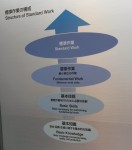Isn’t standardization a good thing? What does “standardize” stand for in lean?
Do you standardize the process so that all cases are treated as one? Or do you know what you’re doing by referring every work situation to a standard: the best known way to do the job with generating as little waste as possible?
“Standardization” is often confused with making things uniform: every one, everywhere, the same. In the West, standardization is technically the process of adopting local standards to support coordination – wouldn’t one single phone adapter be easier? Like most things, some standards are helpful, others not so.
After all the QWERTY standard was adopted at a time when typewriters jammed easily when typing at speed. One smartass invented the most complicated arrangement of letter so that typists would slow down, not jam the machine, and win the competition. The QWERTY standard is designed to make it hard to type without looking at your fingers.
What is standardization in Lean?
In Lean, the idea of standards is one of knowledge, not compliance. Knowing the standard means knowing the best way to do a specific job minimizing the resulting waste. This, essentially, means knowing:
- the outcome for the customer: what really matters to customers?
- the sequence of tasks: to be able to move confidently from one task to the next
- the right/wrong way of doing every task: knowing clear criteria to decide whether the task is done right or wrong.
- The environment in which to do the job: the tools, the organization, the information to get the job done right.
- Who to call in case of doubt: which situations should not be faced on one’s own and who to call for a second opinion.
- How to make suggestions for improvement happen: where or whom does one go to with a better idea, and how to improve the current standard?
Here’s a photo from a poster in Toyota City that shows how they think about standards:

Beyond the sequence of tasks, do we have a good grasp of the basic skills needed to carry each task out right first time, first pass? And beyond that, do we constantly question the impact of how we do the job on safety, quality, variety, cost, environmental performance?
Standards are not the rock you place behind the wheel after kaizen to make sure the process remains as it is. Standards are the flag on the hill which represents the best known way of doing things and that we strive for, even when we’re mired in the mud and it seems impossible. To be truly flexible when doing A and B, we must master the standards for job A, the standards for job B and the standard to change from A to B.









